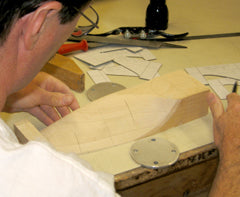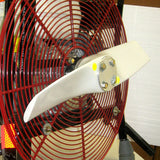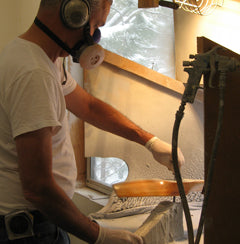Ventry Safety Propellers
What’s so special about our propellers?
Ventry® Safety Propellers are efficient, durable and safe; they are a a significant factor in many of the benefits of Ventry Fans for which these props are manufactured:

- Safety
- High output and low weight
- Less noise and low emissions
- Unbeatable stability
- Placement far back
- Longevity and durability
- Can I use a Ventry Prop on my fan?
Safety
It’s about Safety. Safety. Safety.
Before something goes wrong, make sure your fan is safe! After a near-miss in 2013, Captain Howell found us and switched to Ventry Fans. Read his true story here, shared with permission, to encourage others to consider safety first.
Ventry Safety Propellers are safe. As firefighters, we know that things can go wrong on scene and often do. Our fans are engineered to perform well when things go right and to be safe when things go wrong. The most crucial element of a fan in regard to safety is its prop.
The unique Kevlar-fiberglass-wood composition of Ventry Propellers makes them durable and accepting of a tremendous amount of use and abuse. They are also designed for controlled disintegration, when safety warrants, without the release of high energy projectiles!
Safety Demonstration Video
To demonstrate that crucial point, we made a 1-minute video in which James Neils—who is a firefighter, our CEO, and the Mechanical Engineer who designed the fans and their propellers—stands in the debris path while a Ventry PPV Fan is impaled with a pike pole.
Please note: Before being able to push a pike pole through, we had to bypass the first safety and create a large hole in the fan’s highly-reinforced guard.

When $#!+ Hits the Fan...
...it better be a fail-safe Ventry Fan! This prop was struck by a pike pole. As designed, the affected areas turned into harmless sawdust and the untouched areas remained intact. No shrapnel. No engine damage. No injuries!
True Story
Over the years, we have heard from many customers who are grateful for our uniquely fail-safe technology. Fire Captain Howell (Alaska) shared this close-call with us.
“One of my firefighters almost got killed by an exploding [other manufacturer’s name] fan. He fell backwards onto it while doing a body drag during training. His SCBA cylinder valve hit the fan shroud and the blade broke into 2x2 inch pieces all the way to the hub. I estimate more than a dozen of these exited through the sheet metal of the fan shroud right next to his head and the 4500 psi air cylinder. Those pieces flew so far we were unable to find them. God was with us that day, they all missed him and his equipment.
“Anticipating and addressing failure at the engineering level is the gold standard of engineering, due to the fact that everything will at some point fail or be used inappropriately. You guys foresaw blade failures and took appropriate action.” ~ Captain Howell, City of Bethel FD
After this near-miss in 2013, Captain Howell found us and switched to Ventry Fans. Safety is one of several things to consider before buying any PPV fan.
High CFM and Low Weight

James fine-tuning the 20" 1.5 hp Ventry Fan prop: part engineering, part design, and part experimentation.
Ventry Fans have dual-blade props which utilize the fundamentals of aerodynamics and state-of-the-art proprietary technology. We engineer each propeller specifically for each fan motor, utilizing every bit of horsepower and maximizing the power curve for highest air volume. As a result, Ventry Fans are frequently tested side-by-side and face-to-face with higher-horsepower fans and are chosen again and again after revealing bigger, heavier fans to be unnecessary.
Less Noise and Low Emissions

Other benefits of propeller efficiency—besides high CFM—are significant reductions in noise and carbon monoxide (CO). Moving more air using less horsepower saves you: bulk, weight, expense, noise, and CO exposure.
Do not fall for the “more is better” fallacy of multiple-blade props (or horsepower). The more blades a propeller has, the more they stir the air rather than push it, wasting energy in the form of noise. This is called “form drag” or “eddy making drag” and is due to multiple tips and greater surface area.

A lot of research
and development
go into our propellers!
Open-flow (free flowing) guards also contribute greatly to the relatively low noise level of Ventry PPV Fans.
Unbeatable Stability
The propellers’ composition contributes to the overall stability of every Ventry Fan. Manufactured in-house by Ventry Solutions, Inc., Ventry Safety Propellers are composites of Kevlar® and fiberglass with a wooden core. The wooden core makes the propellers naturally vibration dampening and is, therefore, one of several reasons why Ventry Fans are known to stay put and not walk! (Of course, the outward curving legs are the main reason Ventry Fans are so stable and so hard to tip over.)
Placement of Fan Farther Back
The advanced curvature of the prop—forward sweeping tips—makes for a tighter, more uniform air cone. This high-quality, consistent air cone (as opposed to erratic) helps with aiming and allows the fan to be placed farther away from the target. The narrow air cone pushes air directly at the target instead of around it in a wide circle.
Placement of the fan farther back from its target is crucial for keeping the fan out of the way and one of the major advantages of Ventry Fans over other brands. Firefighters should never have to crawl over the top of a fan while they are using it!

John applies one of several protective paint layers to a propeller (2007).
Longevity/Durability
Always extend the fan’s legs when in use, and its propeller will last decades. If something goes wrong though and safety requires, as one of our customers described, “the propeller will turn to dust so you do not!”
Can I use a Ventry Propeller on another fan?
Yes, a Ventry Propeller may work on another fan, but there are a few technical requirements that must be met.
